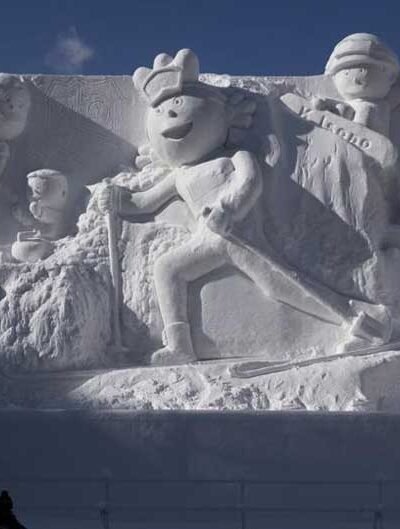When winter wraps Japan in a thick white blanket, the country takes on a serene, enchanted quality. From powdery ski slopes in Hokkaido to snow-covered temples in Kyoto, winter is more than just a season—it’s a spectacle. Nowhere is this more evident than in Japan’s snow festivals and ice sculpture events, where creativity meets frozen artistry in astonishing displays of craftsmanship.
The Origins of Japan’s Snow Festivals
Many of Japan’s iconic snow festivals have roots in regional culture and community efforts. Take the Sapporo Snow Festival, for instance. What began in 1950 with a few local students building snow statues has now grown into one of the most internationally recognised winter events. It’s more than just a celebration of winter; it’s a testament to the imaginative spirit of Japanese communities.
While Sapporo garners the most attention, many smaller towns and cities host their own winter festivals, each with a unique local flavour. From lantern-lit walkways to dragon-shaped ice carvings, these events are woven into the fabric of regional life and offer something more intimate than the mega-festivals.
The Sapporo Snow Festival: A Frozen Wonderland
Held every February, the Sapporo Snow Festival attracts over two million visitors to Hokkaido’s capital. The event is spread across several locations, with Odori Park at the heart of the action. Here, massive snow sculptures—some reaching several stories high—depict everything from famous landmarks to pop culture icons.
But it’s not just about size. The craftsmanship is impeccable. Artists from around the globe come to compete, often working through bitterly cold nights to carve scenes with jaw-dropping detail. At night, lights transform these snow sculptures into glowing monuments, creating a surreal, otherworldly effect.
Susukino, Sapporo’s entertainment district, also plays host to the festival with its own Ice World, where finely sculpted ice statues glisten under multicoloured lights. Many of these feature intricate designs like animals in motion or traditional Japanese motifs frozen in time.
Yokote Kamakura Festival: Warmth Inside the Cold
In Akita Prefecture, the Yokote Kamakura Festival offers a different kind of winter magic. Instead of towering sculptures, the focus is on kamakura—small snow huts that resemble igloos. Each hut contains an altar dedicated to the water deity and a charcoal brazier for warmth.
Visitors are invited inside these huts, where local children offer warm rice cakes and amazake (a sweet fermented rice drink), fostering a rare and heartwarming connection between locals and tourists. It’s an event that feels more like a neighbourhood gathering than a spectacle, making it an unforgettable winter experience.
Lights and Lanterns: Tokamachi and Otaru
In Niigata Prefecture, the Tokamachi Snow Festival transforms a snow-covered landscape into a luminous theatre. The event includes a fashion show on a snowy runway, massive snow slides, and firework displays that paint the sky in contrast to the pristine white below. Despite heavy snowfall, the town embraces the cold with joy and artistic flair.
Otaru, a port city just northwest of Sapporo, is famous for its Snow Light Path Festival. For ten days in February, the city glows with thousands of candles and lanterns lining the canal and walkways. The soft, flickering light reflecting off snowbanks creates a quiet, almost dreamlike atmosphere. It’s less crowded than Sapporo and offers a more contemplative, romantic take on winter beauty.
Things to See in Japan During Winter
Winter in Japan isn’t just about festivals—it’s a gateway to some of the most things to see in Japan that often go overlooked during other seasons. Snow monkeys soaking in hot springs in Nagano’s Jigokudani Park are a perfect example. Covered in snow, these macaques sit in steamy pools with expressions of pure contentment—a surreal and amusing sight.
Historic villages like Shirakawa-go and Gokayama, known for their steep-roofed gassho-zukuri farmhouses, become even more magical under layers of snow. Illuminated during special winter nights, they feel lifted straight from a fairytale. And of course, the winter views of Mount Fuji from Lake Kawaguchi are famously clear and breathtaking.
Ice Art as Cultural Expression
While it’s easy to admire the visual impact of snow and ice sculptures, these works often carry deeper cultural significance. Artists draw from Japanese folklore, mythology, and even contemporary issues, turning their temporary sculptures into messages carved in ice.
In recent years, sustainability themes have also appeared—sculptures promoting climate awareness, for instance, or ice installations that melt in a way designed to provoke reflection. In a sense, the festivals are not just celebrations of beauty but platforms for storytelling.
Why Japan’s Snow Festivals Are Worth the Chill
Whether you’re marvelling at a castle made entirely of snow or sipping warm sake in a candlelit igloo, Japan’s winter festivals deliver moments that linger long after the snow melts. They are carefully orchestrated, deeply cultural, and designed with a kind of precision that feels uniquely Japanese.
For those searching for the things to see in Japan beyond cherry blossoms and temples, winter offers an entirely different lens—one carved from snow, lit by lanterns, and filled with warmth despite the cold.





Leave a Reply